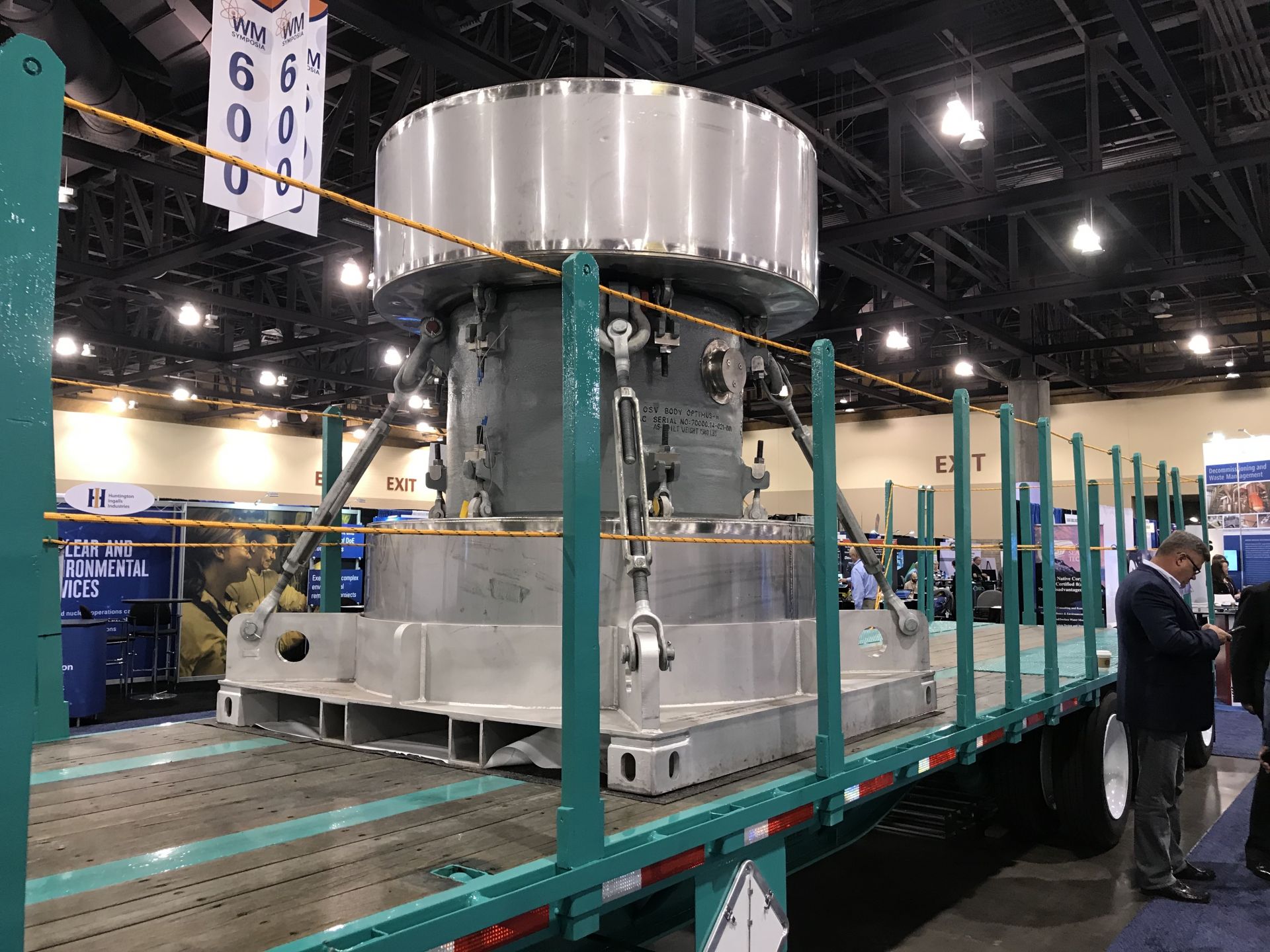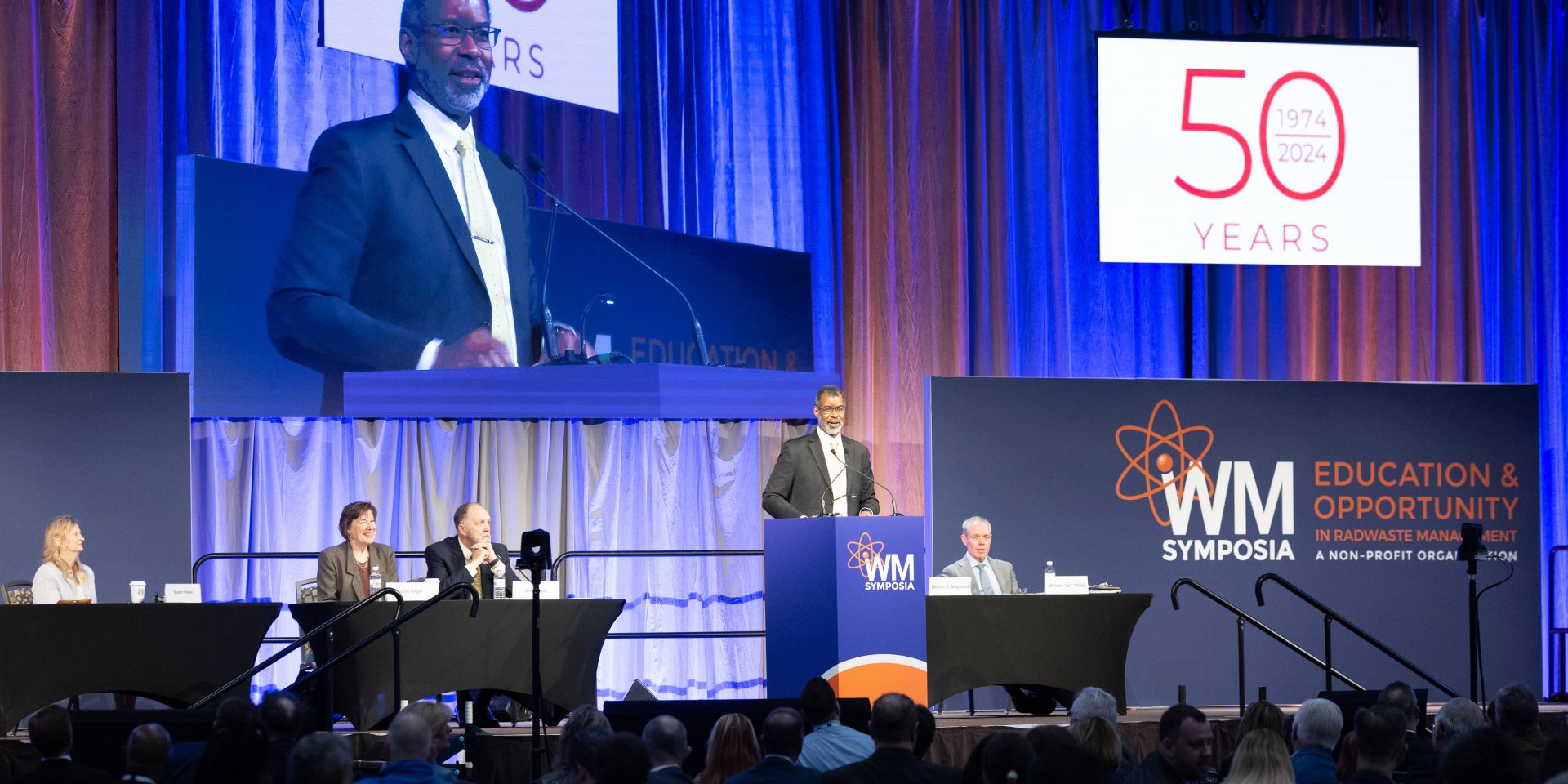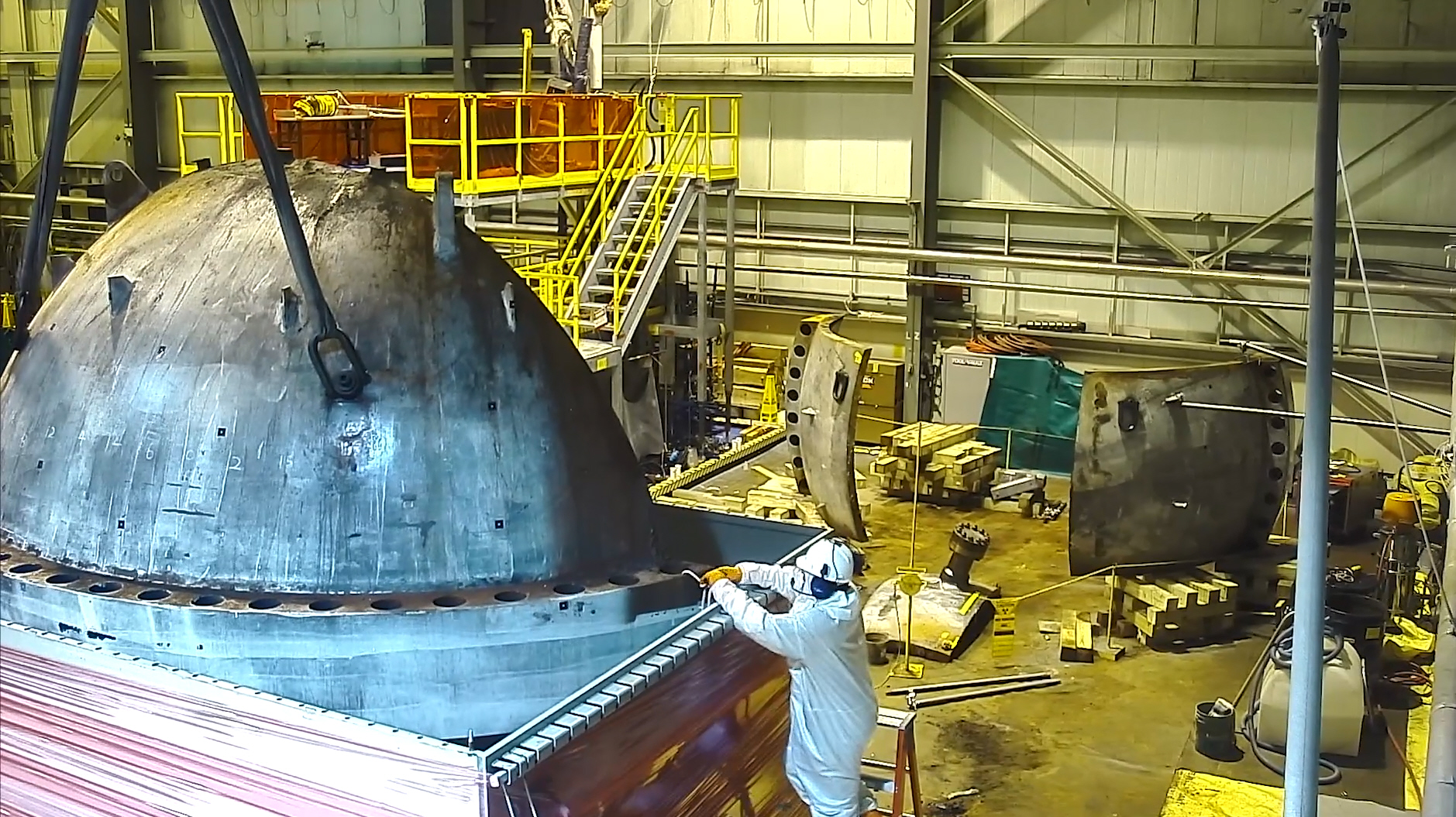The OECD NEA’s William Magwood addresses the plenary audience of the 2024 Waste Management Conference in Phoenix. (Photo: WM Symposia)
This year marked the 50th anniversary of Waste Management Symposia’s Waste Management Conference, held March 10–14 in Phoenix, Ariz. The event has grown significantly since the first Waste Management Conference in 1974, which attracted about 200 attendees. This year’s conference saw a record attendance of around 3,300 people from more than 20 different countries and boasted 235 technical sessions and 89 exhibitors.
Vermont Yankee’s segmented reactor vessel head is lowered into a custom-built package for transportation and disposal. (Photo: Orano)
Currently, the Nuclear Regulatory Commission is overseeing 17 nuclear power plants that are undergoing active decommissioning. For 10 of those plants, the NRC licenses have been transferred, either through sale or temporary transfer, from the plant owner and operator to a third party, nonutility company for decommissioning. To be profitable, those companies are decommissioning the nuclear plants as expediently as they safely can, while still protecting workers and the environment, using proprietary techniques and processes.
SHINE’s isotope production building, called the Chrysalis, under construction in October 2022.
In a former farm field just outside the historic town of Janesville in south-central Wisconsin, a large concrete-and-steel building is taking shape. Dubbed the Chrysalis, the building will eventually house eight accelerator-based neutron generators, which start-up company SHINE Technologies will use to produce molybdenum-99. As the precursor to the medical radioisotope technetium-99m, Mo-99 is used in tens of millions of diagnostic procedures every year, primarily as a radioactive tracer.
At the heart of the Chrysalis will be the high-flux neutron generators, being supplied by SHINE’s sister company, Phoenix. The compact accelerators use a deuterium-tritium fusion process to produce neutrons, which in turn induce a subcritical fission reaction in an aqueous low-enriched uranium target (19.75 percent uranium-235) to produce Mo-99.
In 2020, the DOE announced real progress made in the management of liquid radioactive waste at its sites at Savannah River, Idaho, and Hanford.
Plant startup employees work in the process cell area of the Low-Activity Waste Facility at Hanford’s Waste Treatment and Immobilization Plant.
During the annual National Cleanup Workshop, held virtually in September of last year due to the COVID-19 health crisis, William “Ike” White, senior advisor to the under secretary for science in the Department of Energy’s Office of Environmental Management, said that despite the pandemic, 2020 was an inflection year for the DOE and his office.
The 66th president of the American Nuclear Society takes the helm at a time of great change, both internally and externally.
 Mary Lou Dunzik-Gougar said she feels very fortunate to be taking on the role of president of the American Nuclear Society at this moment in history. “By that, I don’t mean at the time of the COVID-19 pandemic,” she quickly clarified. “I mean at a time when we are making exciting and transformational changes to the Society.”
Mary Lou Dunzik-Gougar said she feels very fortunate to be taking on the role of president of the American Nuclear Society at this moment in history. “By that, I don’t mean at the time of the COVID-19 pandemic,” she quickly clarified. “I mean at a time when we are making exciting and transformational changes to the Society.”
These changes are described in the aptly named Change Plan 2020, which was developed by a group that included ANS past presidents Andy Klein, Gene Grecheck, and Bob Coward, with input from members, including Dunzik-Gougar, and was approved by the ANS Board of Directors at the November 2019 ANS Winter Meeting in Washington, D.C. Already, Change Plan 2020 has reshaped the way the Society interacts with its members, including a new, greatly improved website and an updated, more vibrant and informative Nuclear News magazine. The plan has also reorganized the Society to create, in the words of ANS’s new executive director and chief executive officer, Craig Piercy, a “more streamlined, less siloed organization that is better equipped to meet our members’ needs going forward.”
Producing packages for radioactive materials takes time, attention to detail, and a thorough commitment to quality assurance.

The Optimus-H transport cask on display at the 2020 Waste Management Conference in Phoenix, Ariz.
Jeff England, director of transportation projects for NAC International, pointed to the large stainless steel canister, which looked like a giant-sized silver dumbbell, perched on the flatbed of a semitrailer truck parked in the middle of the expansive exhibit hall in the Phoenix Convention Center. NAC, a provider of nuclear storage, transportation, and consulting services, was using the 2020 Waste Management Conference, held March 8–12 in Phoenix, Ariz., to unveil its newest transport casks, the Optimus-H and Optimus-L.
“These are a different niche,” England said of the casks, which were designed to transport radioactive materials, including remote-handled transuranic waste, high-activity intermediate-level waste, low-enriched uranium, and fissile materials. “You have a lot of [small] drum-sized packages, and you also have a lot of big packages that will hold around 10 55-gallon drums. But there’s not anything in between. We hold a 110-gallon drum capacity.”
As demands for a comprehensive U.S. waste management plan increase, private vendors are certifying new SNF/HLW transportation cask designs.
A large-scale campaign to move spent nuclear fuel and high-level radioactive waste in the United States to a central repository or interim storage site does not appear to be coming anytime soon. External pressures, however, including a growing number of nuclear power plant closures and increased stakeholder demand to remove stranded spent fuel and HLW, are shifting focus to building the infrastructure needed to move large volumes of waste. This includes the design and manufacture of shielded transportation casks for shipping the waste by truck or rail.


-3 2x1.jpg)




 Mary Lou Dunzik-Gougar said she feels very fortunate to be taking on the role of president of the American Nuclear Society at this moment in history. “By that, I don’t mean at the time of the COVID-19 pandemic,” she quickly clarified. “I mean at a time when we are making exciting and transformational changes to the Society.”
Mary Lou Dunzik-Gougar said she feels very fortunate to be taking on the role of president of the American Nuclear Society at this moment in history. “By that, I don’t mean at the time of the COVID-19 pandemic,” she quickly clarified. “I mean at a time when we are making exciting and transformational changes to the Society.”